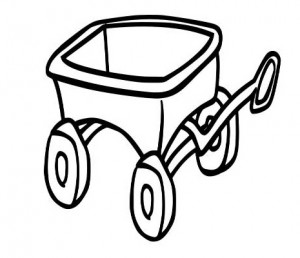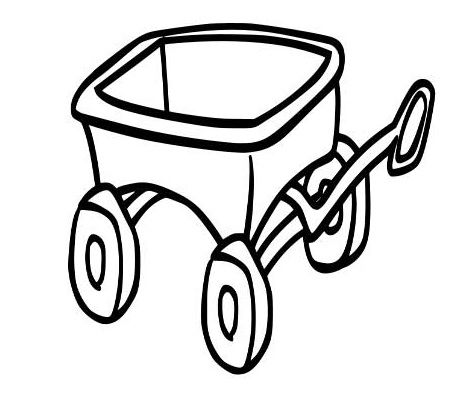 This is a quick and easy demonstration of how to teach Newton’s laws with minimal fuss and materials. All you need is a wagon, a rock, and some friends. We’re going to do a few totally different experiments using the same materials, though, so keep up with the changes as you read through the experiment.
This is a quick and easy demonstration of how to teach Newton’s laws with minimal fuss and materials. All you need is a wagon, a rock, and some friends. We’re going to do a few totally different experiments using the same materials, though, so keep up with the changes as you read through the experiment.
Remember that Newton covers a few different ideas. First, there’s the idea that objects in motion will stay going they way they’re headed, unless something gets in the way. Then there’s the resistance to motion (objects at rest tend to stay put), as well as force being proportional to how fast you can get something to move (acceleration). And lastly, there’s the idea that forces happen in pairs – if you shoot something one direction, you’re going to feel a kick in the opposite direction. Ready to see these ideas in action? Let’s go…
[am4show have=’p8;p9;p11;p38;p12;p39;p92;’ guest_error=’Guest error message’ user_error=’User error message’ ]
Here’s what you need:
- wagon
- a rock
- friends
Part 1: Newton’s First Law (& Inertia)
Let’s really figure out what this ‘inertia’ thing from Newton’s first law is all about using the wagon and friends. Here’s what you need to do:
1. Pull the wagon down the sidewalk.
2. Try to stop as quickly as you can. Be careful. You could get run over by the wagon if you’re not careful.
3. Put a friend in the wagon and repeat steps 1 and 2.
4. Put another friend in the wagon and repeat steps 1 and 2.
5. Again…pretty easy huh?!
You may have noticed that the more friends (the more weight) you had in the wagon the harder it was to get moving and the harder it was to stop. This is inertia. The more weight something has the more inertia it has and the harder it is to get it to go and to stop!
Quiz question: Will a lighter or heaver race car with the same engine win a short-distance race (like the quarter-mile)? Tell me in the comments below what you think!
Advanced students: Download your First Law Lab here. (This is the first of TWO advanced labs!)
Download Student Worksheet & Exercises
Part 2: Newton’s Second Law
Now we’re going to experiment with Newton’s Second Law that deals with force, mass, and acceleration. Are you ready?
1. Start with an empty wagon…
2. Pull it and try to get it to go as fast as it can, as fast as you can. In other words, get it to accelerate.
3. Now add weight. Put something in the wagon that weighs at least 50 lbs. or so (a nice, solid kid comes to mind)
4. Pull it again and get it to go as fast as it can as fast as you can.
5. Add more weight and do it again.
6. Keep adding weight until you have a very difficult time getting it to accelerate.
So what happened here? Force equals mass x acceleration. The mass was the wagon. The force was you pulling. The acceleration was how fast you could get it to speed up. The heavier you got the wagon (the more mass there was) the harder (the more force) you had to pull to get the wagon to move (to accelerate).
Part 3: Newton’s Third Law
Now let’s work with Newton’s Third Law: for every action, there is an equal and opposite reaction. If this next experiment doesn’t work don’t worry about it. You need a fairly low friction skateboard or wagon to make this work, so that’s why it’s here last. You need: A skateboard or a wagon, the heaviest thing you can throw safely, and a sidewalk.
1. Sit in the wagon or on the skateboard (please do not stand up).
2. Throw the heavy thing as hard as you can. Please be careful not to hit anybody or anything.
At this point, you should know what should happen, so what do you think? If you said that the throw forward would move you backward, you’re right! Next time you’re in a small canoe, toss the rock and see what happens to you and your boat. (Any guesses?)
Advanced students: Download your Newton’s Wagon Advanced Lab here (This is the second of TWO advanced labs!)
In this next experiment, we are going to combine the concepts of Newton’s Second Law, acceleration and terminal velocity to explore Newton’s Second a little further. Are you ready?
Exercises
- What is inertia?
- What is Newton’s First Law?
- Will a lighter or heavier race car with the same engine win a short-distance race (like the quarter-mile)?
- What concept does Newton’s Second Law of Motion deal with?
- What is momentum?
- What is the equation for Newton’s Second Law?
- What is Newton’s Third law?
- Give three examples of forces in pairs.
- A rope is attached to a wall. You pick up the rope and pull with all you’ve got. A scientist walks by and adds a force meter to the rope and measures you’re pulling with 50 Newtons. How much force does the wall experience?
- Can rockets travel in space if there’s nothing to push off of? Explain your answer.
[/am4show]


Actually weight and gravity are directly connected to each other. Weight is a measurement of the force of gravity pulling on an object. Consider this:
Let’s use a golf ball as our example of an object. If we were somehow able to go out into space, far away from any star or planet, and we let go of the golf ball out in space, it would just sit there. This object is at rest and it will stay at rest because there are no forces pushing or pulling it. If you let go of the ball while standing on the earth, gravity pulls it to the ground. This as you mentioned is due to the weight of the object.
While we’re on this subject, we need to keep in mind that air also acts against moving objects.
Let’s go back out to space…If you through the golf ball out in space, it will keep moving in that direction until the gravity of some star or planet starts to affect it. This is because there is no air to resist the flight of the ball. If you through the ball while standing on the earth, two main things affect the ball’s journey: air immediately begins to resist the ball’s flight and gravity pulls it to the ground.
Question:
Newtons First Law says that Objects In Motion Will Stay In Motion While Objects In Rest Tends to Stay At Rest. What stops the moving object when there’s nothing in it’s way? Gravity? Or the weight of that object? I never really understood his first law due to that question.